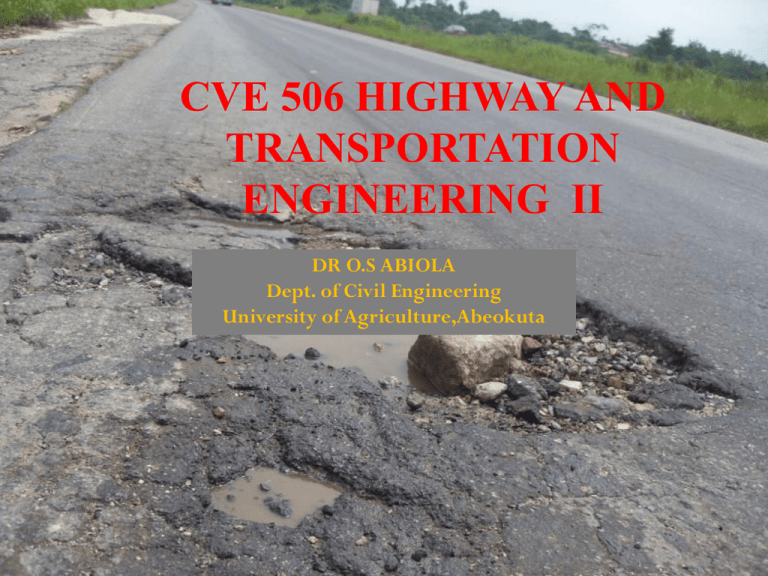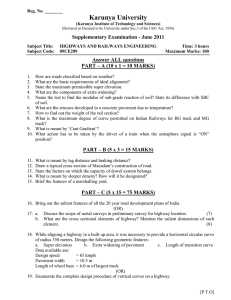cve 506 highway & transportation engineering
advertisement

CVE 506 HIGHWAY AND TRANSPORTATION ENGINEERING II DR O.S ABIOLA Dept. of Civil Engineering University of Agriculture,Abeokuta INTRODUCTION teaching approach & grading policy COURSE OUTLINES Pavement Structure and Designs – Highway, Railway & Airports Construction Materials, Construction and Maintenance Design- Flexible, Rigid and Composite Pavement failures, maintenance and overlays Administration and finance of highways Traffic Safety & management General road maintenance TEXT BOOKS * INTRODUCTION TO TRANSPORTATION ENGINEERING by J.H BANKS * TRAFFIC AND HIGHWAY ENGINEERING by N.J GARBER & L.A HOEL * HIGHWAY ENGINEERING by T.M OGUARA * PRINCIPLES OF PAVEMENT DESIGN by E.J YODER & M.W WITCZAK Construction materials & construction Material selection- the design of pavement systems requires a laboratory testing programme to characterize the materials in each layer including the sub grade. Conventional test procedures California bearing ratio Plate loading Crushing strength Triaxial compression Modulus of rupture Indirect tensile Earthwork operations- are those that involve the earth in its natural form, which need to be undertaken before the actual construction of the pavement structure. Thus all the processes pertaining to grading and construction of the roadbed, which include clearing and grubbing, excavation, construction of embankments and finishing operations for the preparation of highway or runway are earthwork operations. Construction of bituminous pavements- The bulk bituminous pavement construction is hot laid. The majority of bituminous pavements fall into five categories, namely bituminous concrete, plant mix, penetration or bituminous macadam, road mix and surface treatment Pavement structure & Designs Definition of Pavement types Historically, pavements have been divided into two broad categories-flexible and Rigid Flexible pavement may consist of a relatively thin wearing surface built over a base course and sub base course and they rest upon the compacted sub grade. In contrast, rigid pavements are made up of portland cement concrete and may or may not have a base course between the pavement and sub grade. • Highway, Railroad and Airport Compared Design of Flexible Pavement A flexible pavement combines layers of generally different materials in a structural system designed to withstand the cumulative effects of traffic and climate to the extent that, for a pre-determined period, the foundation or sub grade is adequately protected and vehicle operating costs, safety and comfort of the road users are kept within tolerable limits. Basic inputs required for pavement thickness design include, some measure of sub grade strength, the range in climatic conditions, the characteristics of available materials, and estimate of cumulative traffic loading. Design methods Methods of flexible pavement design can be classified into five categories; Empirical method Limiting shear failure method Limiting deflection method Regression method Mechanistic-Empirical method Design Methods Flexible, Rigid & Composite CBR Method Asphalt Institute method National Crushed Stone Association Design Method California Method AASHTO Method Mechanistic design Method Design of Overlays An overlay is one or more courses of asphalt or Portland cement concrete construction on an existing pavement. The overlay generally includes a levelling course to correct the contour of the old pavement, followed by uniform course or courses to provide needed thickness. Importance of Overlay Most overlay design procedures however can be categorized into: Component analysis Deflection-based analysis Analytical or Mechanistic-based procedures Pavement maintenance & Rehabilitation The current AASHTO definition of highway maintenance is: A programme to preserve, repair and restore a system of roadway with its element to its designated or accepted configuration. System elements include travel way surfaces, shoulders, roadsides, drainage facilities, bridges, tunnels, signs, markings, lighting fixtures, etc. Included in the programme are such traffic services as lighting and signal operations, snow and ice removal, and operation of roadside rest areas. Rehabilitation encompasses overlays, recycling, reconstruction and their combinations. Pavement distress Distress is defined as an indication of unfavourable pavement performance or signs of impending failure, or any unsatisfactory performance of pavement short of failure. Distress types in flexible pavements- Cracking, Distortion, Disintegration, Skid hazard Distress types in rigid pavements- Joints and cracks, Distortion, etc. Pavement condition evaluation & surveys Pavement condition evaluation-Evaluation of pavement condition can be described as a process of measuring the functional and structural condition of the pavement followed by verifying whether the condition is above or below predefined minimum acceptance levels and warning levels. Functional condition of a pavement expresses its ability to serve the user, and its major indicators include roughness, skid resistance, riding comfort, aesthetics and other safety considerations. Structural condition addresses whether or not the pavement can support future traffic loadings over the desired design period without structural improvement. Several systems for evaluating the condition of pavements have been developed and used by various highway agencies. Pavement condition surveys- Every highway agency is supposed to collect pavement condition data from time to time to make rational maintenance and rehabilitation decisions. Pavement condition survey results, together with serviceability, drainage and structural evaluation surveys should provide the engineer with necessary information to develop sound maintenance or rehabilitation decisions. Pavement maintenance management systems-a number of procedures have been developed for pavement maintenance management. The essence of these procedures is to provide a consistent, reasonably objective and systematic approach for establishing priorities, scheduling and budgeting roadway maintenance and rehabilitation requirements. Traffic safety & Management Issues involved in Transportation safety Crashes or accidents- accidents is the common accepted word for occurrence involving one or more transportation vehicles in a collision that results in property damages, injury, or death. The term “accident” implies a random event that occurs for no apparent reason other than “it just happen.” What causes transportation crashes- the occurrence of transportation crash presents a challenge to safety investigators. In every instance the question arises, “what sequence of events or circumstances contributed to the incident that resulted in injury, loss of lives or property damage?” Factors involved in Transportation crashes- the driver, vehicle, roadway, environment. Effectiveness of safety design features-pedestrian safety improvements, driver behaviour & performance etc. CLASS PROJECT






